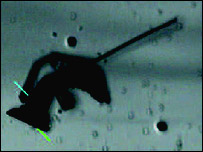
Thin thighs – maybe not your heart’s desire
People who have agonized over their fat thighs might be able to relax a bit — Danish doctors said on Thursday they found patients with the thinnest thighs died sooner than the more endowed.
Obesity, age, smoking and other factors did not reduce the effect, the researchers reported in the British Medical Journal.
“Our results suggest that there might be an increased risk of premature death related to thigh size,” Berit Heitmann of Copenhagen University Hospital and Peder Frederiksen of Glostrup University Hospital wrote.
The explanation may lie in many different studies that suggest where you gain your weight is a strong factor in how it affects health. People with lots of abdominal fat — wrapped in and around the internal organs — appear to be at higher risk of heart disease, diabetes, and other ills.
So-called pear-shaped people may have lower risks, even if they have more body fat overall.
Heitmann and Frederiksen studied 1,436 men and 1,380 women taking part in a larger medical research study who were examined in 1987 and 1988, then watched them for more than 12 years.
Men and women whose thighs were less than 24 inches in circumference were more likely to die during those 12 years, they found.
Those with the thinnest thighs — less than 18 inches — were more than twice likely to have died within 12 years, they reported in the study, published here
Dozens of studies have shown waist size can also be a good predictor of heart disease and death.
Women with a waist circumference of greater than 35 inches and men whose waists are more than 40 inches have a much higher risk of heart disease, diabetes and early death than people with smaller waists — regardless of how much body fat they have overall.
This is again linked to abdominal fat. Fat laid down under the skin, as when it is found on the legs, may be healthier for the body, although the mechanism is unclear.
The Danish team said they hoped thigh measurements might be an equally good indicator. But Dr. Ian Scott of Princess Alexandra Hospital in Brisbane, Australia, disagreed, saying the statistics in the Danish study were too limited.
He said larger studies would need to be done before doctors could decide that thigh measurement was any kind of good predictor of health.
“It seems unlikely that thigh circumference will be clinically useful,” Scott wrote in a commentary.
Tim Olds, a professor of Health Sciences at the University of South Australia, saw some value in the study, however.
“This is a very interesting line of research, because it would suggest that interventions which protect or increase muscle mass (such as weight training) may be effective in reducing cardiovascular disease even if no loss of body fat occurs,” Olds said in a statement.
Thin thighs , Thin thighs Health, Thin thighs Health Latest, Thin thighs Health Information, Thin thighs Health information, Thin thighs Health Photo,Exercising for Weight Health photo, Thin thighs Health Latest, Thin thighs Health latest, Exercising for Weight Health Story, Healthy Minnesota Health story, Thin thighs Video, Thin thighs video, Thin thighs Health History, Thin thighs Health history, Thin thighs over Picture, history, Thin thighs Asia, Healthy Minnesota asia, Thin thighs Gallery, Exercising for Weight gallery, Thin thighs Photo Gallery, Healthy Minnesota photo gallery, Thin thighs Picture, Thin thighs picture, Thin thighs Web, Malaysia Health, web Health, web Health picture, video photo, video surgery, gallery, laparoscopy, virus, flu, drug, video, Health Health, calories, photo, nutrition, health video, symptoms, cancer, medical, beating, diet, physical, Training, organic, gym, blister, exercise, weightloss, surgery, spiritual, eating, tips, skin, operation, bf1, Thin, thighs




